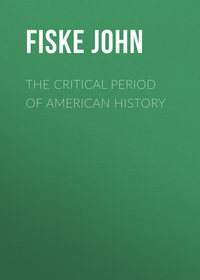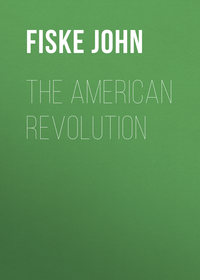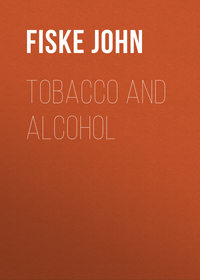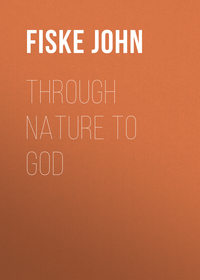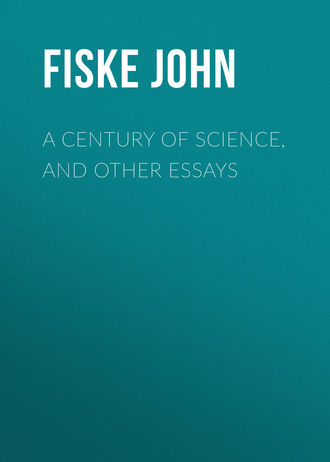 полная версия
полная версияA Century of Science, and Other Essays
In this way, Cambridge, which had hitherto faced the Brighton mainland, turned its face toward the Boston peninsula, and two new villages began to grow up at "the Port" and "the Point," otherwise Cambridgeport and East Cambridge. It was not long before the new villages began in some ways to assert rivalry with the old one. The corporation which owned the bridge and large tracts of land at Lechmere Point naturally wished to increase the value of its real estate. Middlesex County needed a new courthouse and jail. In 1757 a new courthouse had been built on the site of Lyceum Hall, but in 1813 there was a need for something better; whereupon the Lechmere Point Corporation forthwith built a courthouse and jail in East Cambridge, and presented them, with the ground on which they stood, to the county. In 1818, a lot of land in the Port, bounded by Harvard, Prospect, Austin, and Norfolk streets, was appropriated for a poorhouse. Soon afterward it was proposed to inclose our common, – which with the lapse of time had shrunk to about its present size, – and to convert it from a grazing ground into an ornamental park. The scheme met with vehement opposition, and the town meetings in this growing community suddenly became so large that the old courthouse in Harvard Square would not hold them. Accordingly, a bigger townhouse was built in 1832 on the eastern part of the poorhouse lot, and thus was the civic centre removed from Old Cambridge.
This event served to emphasize the state of things which had been growing up with increasing rapidity since the beginning of the century. Instead of a single village, with a single circle of interests, there were now three villages, with interests diverse and sometimes conflicting as regards the expending of public money, so that feelings of sectional antagonism were developed.
In New England history, the usual remedy for such a state of things has been what might be called "spontaneous fission." The overgrown town would divide into three, and the segments would go on pouting at each other as independent neighbours. We need not be surprised to learn that in 1842 the people of Old Cambridge petitioned to be set off as a separate town; but this attempt was successfully opposed, with the result that in 1846 a city government was adopted. In that year the population had reached 13,000, and was approaching the point at which town meetings become unmanageable from sheer bulk. For small communities, Thomas Jefferson was probably right in holding that the town meeting is the best form of government ever devised by man. It was certainly the form best loved in New England down to 1822, when Boston, with its population of 40,000, reluctantly gave it up, and adopted a representative government instead. The example of Boston was followed in 1836 by Salem and Lowell, and next in 1846 by Roxbury and Cambridge. From that time forth the making of cities went on more rapidly. It was the beginning of a period of urban development, the end of which we cannot as yet even dimly foresee. This unprecedented growth of cities is sometimes spoken of as peculiarly American, but it is indeed not less remarkable in Europe, and it extends over the world so far as the influence of railroad and telegraph extends. The influence of these agencies of communication serves to diffuse over wide areas the effects wrought by machinery at different centres of production. With increased demand for human energy, the earth's power of sustaining human life has vastly increased, and there is a strong tendency to congregate about centres of production and exchange. In 1846 there were but five cities in the United States with a population exceeding 100,000; New York had not yet reached half a million. To-day New York is approaching the two-million mark, three other cities28 have passed the million, and not less than thirty have passed the hundred-thousand. During this half century the 13,000 of Cambridge have increased to more than 80,000. The Cambridge of to-day contains as many people as the Boston of sixty years ago.
The causes of this growth of Cambridge might be treated, had we space for it, under three heads. Our city has grown because of its proximity to Boston; it has grown by reason of its flourishing manufactures; and it has grown with the growth of the University. That Cambridge should have shared in the general prosperity of this whole suburban region is but natural. But persons at a distance are apt to show surprise when we speak of it as a manufacturing city. This feature in our development belongs to the period subsequent to 1846, and has much to do with the growth of the eastern portions of Cambridge, where the combined facilities for railroad and water communication have been peculiarly favourable to manufactures. In the early part of this century, the glassworks at East Cambridge, which have since departed, were somewhat famous, considerable manufactures of soap and leather had been begun, and cars and wagons were made here. At the present time some of our chief manufactures are of engine boilers and various kinds of machinery, of which the annual product exceeds $2,000,000. Among the industries which produce in yearly value more than $1,000,000 may be mentioned printing and publishing, musical instruments (especially pianos and organs), furniture, clothing, carpenter's work, soap and candles, biscuit-baking; while among those that produce $500,000 or more are carriage-making and wheelwright's work, plumbing and plumber's materials, bricks and tiles, and confectionery. Not only our own new Harvard Bridge, but most of the steel railway bridges in New England, have been built in Cambridge. We supply a considerable part of the world with hydraulic engines; the United States Navy comes here for its pumps, and our pumping machines may be seen at work in Honolulu, in Sydney, in St. Petersburg. In the dimensions of its pork-packing industry, Cambridge comes next after Chicago and Kansas City. In 1842 all the fish-netting used in America was made in England; to-day it is chiefly made in East Cambridge, which also furnishes the twine prized by disciples of Izaak Walton in many parts of the world. Last year the potteries on Walden Street turned out seven million flower-pots. Such facts as these bear witness to the unusual facilities of our city, where coal can be taken and freight can be shipped at the very door of the factory, where taxes and insurance are not burdensome and the fire department is unsurpassed for efficiency, where skilled labour is easy to get because good workmen find life comfortable and attractive, with excellent sanitary conditions and unrivalled means of free education, even to the Latin School and the Manual Training School. It is well said, in one of the reports in our semi-centennial volume, that "to Cambridge herself, as much as to any other one thing, is the success of all her manufacturing enterprises due, and all agree in acknowledging it."
Among Cambridge industries, two may be mentioned as especially characteristic and famous. Of the printing establishments now existing, not many can be more venerable than our University Press, of which we have spoken as beginning in 1639. Of the wise and genial founder of the Riverside Press – who once was mayor of our city, and whose memory we love and revere – it may be said that few men of recent times have had a higher conception of bookmaking as one of the fine arts. These two institutions have set a lofty standard for the Athenæum Press, which has lately come to bear them company. The past half century has seen Cambridge come into the foremost rank among the few publishing centres of the world, where books are printed with faultless accuracy and artistic taste.
The visitor to Cambridge from Brookline, as he leaves the bridge at Brookline Street, comes upon a pleasant dwelling house, with a private observatory, and hard by it a plain brick building. That is the shop of Alvan Clark & Sons, who have carried the art of telescope-making to a height never reached before. There have been made the most powerful refracting telescopes in the world, and one of the firm, more than thirty years ago, himself acquired fame as an astronomer for his discovery of the companion of Sirius.
From this quiet nook in the Port one's thoughts naturally turn to the Harvard Observatory, which in those days the two Bonds made famous for their accurate methods of research, their discoveries relating to the planet Saturn, and their share in the application of photography to telescopic observation. The honourable position then taken by the Observatory has been since maintained; but as we note this, we find ourselves brought to the consideration of the University and its last half century of growth. And here my remarks cannot help taking the form, to some extent, of personal reminiscences.
When I first came to Old Cambridge, in 1860, it still had much of the village look, which it has since been fast losing. Pretty much all the spaces now covered by street after street of wooden "Queen Anne" houses, in such proximity as to make one instinctively look for the whereabouts of the nearest fire alarm, were then open, smiling fields. The old house where the Shepard Church stands was rural enough for the Berkshire Hills; and on the site of Austin Hall, in the doorway of a homestead built in 1710, one might pause for a cosy chat with the venerable and courtly Royal Morse, whose personal recollections went back into the eighteenth century. The trees on the common were the merest saplings, but an elm of mighty sweep, whose loss one must regret, shaded the whole of Harvard Square. Horse cars came and went on week days, but on Sunday he who would visit Boston must either walk or take an omnibus, in which riding was a penance severe enough to atone for the sin. "Blue Laws" in the University were in full force; the student who spent his Sundays at home in Boston must bring out a certificate showing that he had attended divine service twice; no discretion was allowed the parents.
College athletics were in their infancy, as the little gymnasium still standing serves to remind us. There were rowing matches, but baseball had not come upon the scene, and football had just been summarily suppressed. The first college exercise in which I took part was the burial of the football, with solemn rites, in a corner of this Delta. On Class Day there was no need for closing the yard; there was room enough for all, and groups of youths and maidens in light summer dress, dancing on the green before Holworthy, made a charming picture, like that of an ancient May Day in merry England, save for the broiling heat.
The examination days which followed were more searching than at other American colleges. The courses of study were on the whole better arranged than elsewhere, but during the first half of the course everything was prescribed, and in the last half the elective system played but a subordinate part. The system of examinations did not extend to the Law School, where a simple residence of three terms entitled a student to receive the bachelor's degree. The library at Gore Hall had less than one fifth of its present volumes, with no catalogue accessible to the public, while one small table accommodated all the readers. For laboratory work the facilities were meagre, and very little was done. We all studied a book of chemistry; how many of us ever really looked at such things as manganese or antimony? For the student of biology the provision was better, for the Botanic Garden was very helpful, and in the autumn of 1860 was opened the first section of our glorious Museum of Comparative Zoölogy.
Here one is naturally led to the reflection that in that day of small things, as some might call it, there were spiritual influences operative at Harvard which more than made up for shortcomings in material equipment. There is a kind of human presence, all too rare in this world, which is in itself a stimulus and an education worth more than all the scholastic artifices that the wit of man has devised; for in the mere contact with it one's mind is trained and widened as if by enchantment. Such a human presence in Cambridge was Louis Agassiz. Can one ever forget that beaming face as he used to come strolling across the yard, with lighted cigar, in serene obliviousness of the University statutes? Scarcely had one passed him, when one might exchange a pleasant word with Asa Gray, or descry in some arching vista the picturesque figures of Sophocles or Peirce, or, turning up Brattle Street, encounter, with a thrill of pleasure not untinged with awe, Longfellow and Lowell walking side by side. In such wise are the streets and lawns of our city hallowed by the human presences that once graced them; and few are the things to be had for which one would exchange the memories of those days!
My class of 1863, with 120 members, was the largest that had been graduated here. It would have been larger but for the Civil War, and a period followed with classes of less than 100 members, – a sad commentary upon the times. Boundless possibilities of valuable achievement must be sacrificed to secure the supreme end, that the commonwealth should not suffer harm. How nobly Harvard responded to the demand is recorded upon the solemn tablets in this Memorial Hall. For those who are inclined to dally with the thought that war is something that may be undertaken lightly and with frolicsome heart, this sacred precinct and the monument on yonder common have their lesson that may well be pondered.
The vast growth of our country since the Civil War has been attended with the creation of new universities and the enlargement of the old ones to such an extent as to show that the demand for higher education more than keeps pace with the increase of population. The last graduating class in our Quinquennial Catalogue numbered 350 members. The University contains more than 3000 students.29 The increase in number of instructors, in courses of instruction, in laboratories and museums, in facilities and appliances of every sort, has wrought changes like those in a fairy tale. The Annual Catalogue is getting to be as multifarious as Bradshaws Guide, and a trained intellect is required to read it. The little college of half a century ago has bloomed forth as one of the worlds foremost universities. Such things can come from great opportunities wielded and made the most of by clearness of vision and administrative capacity.
To this growth of the University must be added the most happy inception and growth of Radcliffe College, marking as it does the maturing of a new era in the education of women. We may well wish for Radcliffe a career as noble and as useful as that of Harvard, and I doubt not that such is in store for it. A word must be said of the Episcopal Theological School, based upon ideas as sound and broad as Christianity; and of the New-Church Theological School, more recently founded. We must hail such indications of the tendency toward making our Cambridge the centre for the untrammelled study of the most vital problems that can occupy the human mind.
But the day we are celebrating is a civic, not a university occasion, and I must dwell no longer upon academic themes. We are signalizing the anniversary of the change which we once made from government by town meeting to city government. Have we a good reason for celebrating that change? Has our career as a civic community been worthy of approval? In answering this question, I shall not undertake to sum up the story of our public schools and library; our hospital and charity organizations; the excellent and harmonious work of our churches, Protestant and Catholic; our Prospect Union, warmly to be commended; our arrangements for water supply and sewage; and our admirable park system (in which we may express a hope that Elmwood will be included). This interesting and suggestive story may be read in the semi-centennial volume, "The Cambridge of Eighteen Hundred and Ninety-Six," just issued from the Riverside Press. It is an enlivening story of progress, but like every story it has a moral, and I am going to pass over details and make straight for that moral. Americans are a bragging race because they have enjoyed immense opportunities, and are apt to forget that the true merit lies, not in the opportunity, but in the use we make of it. Much gratifying progress can be achieved in spite of the worst sort of blundering and sinning on the part of governments. The greater part, indeed, of human progress within historic times has been thus achieved. A good deal of the progress of which Americans are wont to boast has been thus achieved. Now the moral of our story is closely concerned with the fact that in the city of Cambridge such has not been the case. Our city government has from the outset been upright, intelligent, and helpful. We are satisfied with it. We do not wish to change it. In this respect the experience of Cambridge is very different from that of many other American cities. The government of our cities is acknowledged to be a problem of rare difficulty, so that it has begun to seem a natural line of promotion for a successful mayor to elect him governor, and then to send him to the White House! In some cities one finds people inclined to give up the problem as insoluble. I was lately assured by a gentleman in a city which I will not name, but more than a thousand miles from here, that the only cure for the accumulated wrongs of that community would be an occasional coup d'état, with the massacre of all the city officers. So the last word of our boasted progress, when it comes to municipal government, is declared to be the Oriental idea of "despotism tempered by assassination"! Now to what cause or causes are we to ascribe the contrast between Cambridge and the cities that are so wretchedly governed? The answer is, that in Cambridge we keep city government clear of politics, we do not mix up municipal questions with national questions. If I may repeat what I have said elsewhere, "since the object of a municipal election is simply to secure an upright and efficient municipal government, to elect a city magistrate because he is a Republican or a Democrat is about as sensible as to elect him because he believes in homœopathy or has a taste for chrysanthemums." Upon this plain and obvious principle of common sense our city has acted, on the whole with remarkable success, during its half century of municipal existence. The results we see all about us, and the example may be commended as an object lesson to all who are interested in the most vital work that can occupy the mind of an American, – the work of elevating the moral tone of public life. For it is neither wealth, nor power, nor cunning, nor craft that exalts a nation, but righteousness and the fear of the Lord.
May, 1896.
XI
A HARVEST OF IRISH FOLK-LORE
Since the days when Castrèn made his arduous journeys of linguistic exploration in Siberia, or when the brothers Grimm collected their rich treasures of folk-lore from the lips of German peasants, an active quest of vocables and myths has been conducted with much zeal and energy in nearly all parts of the world. We have tales, proverbs, fragments of verse, superstitious beliefs and usages, from Greenland, from the southern Pacific, from the mountaineers of Thibet and the freedmen upon Georgia plantations. We follow astute Reynard to the land of the Hottentots, and find the ubiquitous Jack planting his beanstalk among the Dog-Rib Indians. At the same time, the nooks and corners of Europe have been ransacked with bountiful results; so that whereas our grandfathers, in speculating about the opinions and mental habits of people in low stages of culture, were dealing with a subject about which they knew almost nothing, on the other hand, our chief difficulty to-day is in shaping and managing the enormous mass of data which keen and patient inquirers have collected. It is well that this work has been carried so far in our time, for modern habits of thought are fast exterminating the Old World fancies. Railroad, newspaper, and telegraphic bulletin of prices are carrying everything before them. The peasant's quaint dialect and his fascinating myth tales are disappearing along with his picturesque dress; and savages, such of them as do not succumb to fire-water, are fast taking on the airs and manners of civilized folk. It is high time to be gathering in all the primitive lore we can find, before the men and women in whose minds it is still a living reality have all passed from the scene.
The collection of Irish myth stories lately published by Mr. Jeremiah Curtin30 is the result of a myth-hunting visit which the author made in Ireland in 1887, and is one of the most interesting and valuable contributions to the study of folk-lore that have been made for many years. "All the tales in my collection," says Mr. Curtin, "of which those printed in this volume form but a part, were taken down from the mouths of men who, with one or two exceptions, spoke only Gaelic, or but little English, and that imperfectly. These men belong to a group of persons all of whom are well advanced in years, and some very old; with them will pass away the majority of the story-tellers of Ireland, unless new interest in the ancient language and lore of the country is roused.
"For years previous to my visit of 1887 I was not without hope of finding some myth tales in a good state of preservation. I was led to entertain this hope by indications in the few Irish stories already published, and by certain tales and beliefs that I had taken down myself from old Irish persons in the United States. Still, during the earlier part of my visit in Ireland, I was greatly afraid that the best myth materials had perished. Inquiries as to who might be in possession of these old stories seemed fruitless for a considerable time. The persons whom I met that were capable of reading the Gaelic language had never collected stories, and could refer only in a general way to the districts in which the ancient language was still living. All that was left was to seek out the old people for whom Gaelic is the every-day speech, and trust to fortune to find the story-tellers."
Thus Mr. Curtin was led to explore the counties of Kerry, Galway, and Donegal. "Comforting myself with the Russian proverb that 'game runs to meet the hunter,' I set out on my pilgrimage, giving more prominence to the study and investigation of Gaelic, which, though one of the two objects of my visit, was not the first. In this way I thought to come more surely upon men who had myth tales in their minds than if I went directly seeking for them. I was not disappointed, for in all my journeyings I did not meet a single person who knew a myth tale or an old story who was not fond of Gaelic, and specially expert in the use of it, while I found very few story-tellers from whom a myth tale could be obtained unless in the Gaelic language; and in no case have I found a story in the possession of a man or woman who knew only English."
There is something so interesting in this fact, and so pathetic in the explanation of it, that we are tempted to quote further: "Since all mental training in Ireland is directed by powers both foreign and hostile to everything Gaelic, the moment a man leaves the sphere of that class which uses Gaelic as an every-day language, and which clings to the ancient ideas of the people, everything which he left behind seems to him valueless, senseless, and vulgar; consequently he takes no care to retain it, either in whole or in part. Hence the clean sweep of myth tales in one part of the country, – the greater part, occupied by a majority of the people; while they are still preserved in other and remoter districts, inhabited by men who, for the scholar and the student of mankind, are by far the most interesting in Ireland."
The fate of the Gaelic language has, indeed, been peculiarly sad. In various parts of Europe, and especially among the western Slavs, the native tongues have been to some extent displaced by the speech of conquering peoples; yet it is only in Erin that, within modern times, a "language of Aryan stock has been driven first from public use, and then dropped from the worship of God and the life of the fireside." Hence, while in many parts of Europe the ancient tales live on, often with their incidents more or less dislocated and their significance quite blurred, on the other hand, in English-speaking Ireland they have been cleared away "as a forest is felled by the axe."
Nevertheless, in the regions where Irish myths have been preserved, they have been remarkably well preserved, and bear unmistakable marks of their vast antiquity. One very noticeable feature in these myths is the definiteness and precision of detail with which the personages and their fields of action are brought before us. This is a characteristic of mythologies which are, comparatively speaking, intact; and, as Mr. Curtin observes, it is to be seen in the myths of the American Indians. As long as a mythology remains intact it "puts its imprint on the whole region to which it belongs." Every rock, every spring, is the scene of some definite incident; every hill has its mythical people, who are as real to the narrators as the flesh-and-blood population which one finds there. In this whole world of belief and sentiment there is the vigour of fresh life, and the country is literally enchanted ground. But when, through the invasion of alien peoples, there is a mingling and conflict of sacred stories, and new groups of ideas and associations have partly displaced the old ones, so that only the argument or general statement of the ancient myth is retained, and perhaps even that but partially, then "all precision and details with reference to persons and places vanish; they become indefinite; are in some kingdom, some place, – nowhere in particular." There is this vagueness in the folk-tales of eastern and central Europe as contrasted with those of Ireland. "Where there was or where there was not," says the Magyar, "there was in the world;" or, if the Russian hero goes anywhere, it is simply across forty-nine kingdoms, etc.; "but in the Irish tales he is always a person of known condition in a specified place" (for example, "There was a blacksmith in Dunkenealy, beyond Killybegs," etc., page 244).


